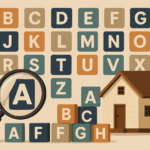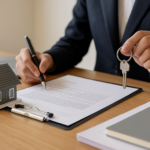As the infamous Benjamin Franklin once said:
By failing to prepare, you are preparing to fail.
And it’s really the same for property investors – property investment is a process not an event and should always start with a strategic property plan.

Tip: Remember… buying a property or doing some research on the Internet is not a property investment plan in itself.
The problem is that most people become property investors without putting much thought into it – and some upgrade their homes and turn their old houses into investments.
This generally doesn't make a good investment because a home is usually bought for emotional, not objective reasons.
Other investors buy an off-the-plan property based on promises that are made by marketers, while other investors only buy a property in their comfort zone – perhaps something that is close to where they live.
But strategic investors devise a property plan - it’s a strategy whereby they bring their future into the present and devise a plan to achieve the results they want.
What does a property plan look like?
Creating a property investment plan is the first essential step for any investor looking to embark on a property investment journey.

Tip: Remember, wealth doesn’t just happen, it’s the result of a well-executed strategic property plan to get you to your end goal.
First, you need to document a proven property investment plan that aligns with your risk profile, goals and time frame.

Note: At Metropole, we help our clients develop financial freedom by building a substantial asset base of investment-grade properties that will give them passive residual income in their future years.
Our plan isn’t to beat the short-term averages, but instead to “safely” outperform the markets in the long term.
And this means we always stay clear of “get-rich-quick schemes”.
In my experience, winning strategies usually lend themselves to a tortoise pace of slow and steady, rather than quick like the hare.

Note: Launching yourself into property investment without a property plan in place and without knowing the stakes or understanding the pros and cons is a recipe for financial disaster.

This is proven by statistics, which show that 50% of investors sell up in the first five years of purchasing their property, and 92% of all Australian investors never get past their first or second property.
It all starts with a strategic plan.
While most buyer’s agents will take an order and either look for a property for you or, in many cases, just give you one of their stock list, at Metropole, we believe you need to start with a strategic property plan, but that’s much more than just about which property you should buy.
We start by helping our clients define their financial goals, and then by using very powerful software, that clients also have access to, we tell them whether their goals are realistic, especially for their timeline, but the plan has various sub-parts that will help us measure our clients progress toward their goals, find ways of maximising their wealth creation through property and identifying risks that they never thought of.The real benefit to our clients is that they are able to grow their wealth through property faster and safer than the average investor.
A good Strategic Property Plan contains the following components:
- An asset accumulation strategy
- A manufacturing capital growth strategy
- A rental growth strategy
- An asset protection and tax minimisation strategy
- A finance strategy including long-term debt reduction and…
- A living off your property portfolio strategy
There is not one size fits all when it comes to property investment, and at different stages in your property journey you will incorporate different strategies in your plan, let’s look at eight concepts a strategic investor may incorporate into their plan.
Property plan 1: Negative gearing
Put simply; gearing means that you have borrowed money to buy your investment property.
There are two types of plans when it comes to gearing - negative gearing and positive gearing.
A property investment plan using negative gearing involves buying a property in a high capital growth suburb, but where the net rental return is lower than the cost of holding the property.
In other words, you make a cash flow loss.
Now while some people will “poo pah” this type of strategy, they don’t realise that residential real estate is a high-growth, relatively low-yield investment and as long as you borrow substantial funds to buy your property, you will always initially run a cash flow loss (even though your property may be increasing substantially.)
In terms of Australian tax law, it’s not actually all that bad.
That’s because the Australian Tax Office (ATO) allows property investors to deduct the loss made on their investment property from their annual taxable income.

Note: The fact is, strategic investors who purchase properties for the long-term capital growth don’t usually expect to make their money on the rent.
They know that cash flow will keep them in the game, but it’s really capital growth that will get them out of the rat race, so they set themselves up with cash flow buffers to see them through the early years of negative gearing.
The pros of using this type of property investment plan are that if you know what you’re doing, you can legitimately claim a tax deduction with this plan and use your tax to help cover the expenses of holding the property investment.
Case study
Sarah buys an investment property for $800,000 in Sydney with a 20% deposit, which means she borrowed $640,000.
The area where she bought the property has strong rental demand, and hopes to hold the property for 10 years or more in order to benefit from capital growth.
She rents the property for $538 per week, earning $28,000 in annual rental income.
Her mortgage costs her $30,000 per year, property management fees amount to $3,000 per year, maintenance costs are around $2,000 per year and then she pays $2,500 in insurance and council rates.
Sarah’s total annual expenses are $37,500.
The difference in income versus costs means Sarah has a loss of $9,500 per year, which puts her in a negatively geared position.
The benefit, however, is that she can claim the $9,500 loss against her taxable income, which reduces the amount of income tax she owes.
Of course, over the year, it’s likely that her property has increased in value by at least $60,000, so on balance, Sarah is ahead.
Property plan 2: Positive gearing
Positive gearing is the second type of gearing-related cash flow property plan.
This is when the income earned from a rental property covers the expenses incurred in holding the property rather than making a cash flow loss.
By the way, a property is not the cash flow positive or negative, it all has to do with how much finance you take out to leverage your property investment.

Tip: Investors tend to want cash flow for choices in their lives, but as I see it, you need to build an asset base first and then buy cash flow – it must be in the right order.
Those looking for positive gearing are thinking about the here and now rather than the long-term and buy properties that may solve a short-term problem, but won’t give them the long-term results they’re hoping for, as in general, they are forgoing strong capital growth
That’s why having a strategic plan that maps out the future returns of your property is critical before you even start thinking about location or a particular property.
Case study
James, like Sarah, also buys an investment property for $800,000 with a 20% deposit and borrows the remaining $640,000.
But he rents his property for $1,000 per week, earning $52,000 in annual rental income.
His costs are the same as Sarah - $30,000 per year for the mortgage, $3,000 for property management fees, $2,000 for maintenance costs and $2,500 in insurance and council rates - meaning his total annual expenses are also $37,500.
But the difference in income versus costs means James earns a profit of $13,000 per year, putting him in a positively geared position.
But there are tax implications too.
Since James earns an additional $13,000 in profit, he needs to pay tax on this additional income, meaning he’ll owe money to the ATO.
Now it’s not easy to find a property that yields 6.5% as James has achieved in this hypothetical example, and the only place to find these are in secondary locations where strategic investors are not prepared to buy.
Property plan 3: Using equity
This property investment plan involves using the equity from your home to help buy your first investment.
Put simply, equity in a property is the difference between the current market value of the property and how much is owed on it.
For example, if your property is worth $800,000 and the current remaining debt on your home loan is $500,000, then you have $300,000 of equity in your property.
You may have thought of your home as a never-ending series of monthly home loan repayments, but with every repayment you make you are building your equity.
It’s worth noting that there is a difference between the equity in your home and your usable or borrowable equity.

Tip: That means that, first, you need to calculate your usable equity and then work out how much you can borrow against that equity.
By using equity to buy a first or subsequent investment property, you can avoid the deposit-saving process (and also avoid selling your home).
Essentially, you’re using your equity as a deposit.
Keep in mind that the loan product you choose and the amount of equity you are looking to access may result in various fees and costs, such as Lenders' Mortgage Insurance, or if you decide to switch to another lender, there may be costs such as fees associated with breaking from a fixed rate product, a new loan application fee or government fees.
Case study
Emma bought her home 10 years ago for $500,000.
Today, it has appreciated in value to $900,000, and at the same time, she has paid her mortgage down, so there is only $300,000 remaining on the loan.
Because her property is now worth $900,000 and her outstanding mortgage is $300,000, Emma has $600,000 in equity.
A lender typically allows homeowners to borrow up to 80% of a property’s value for safety.
80% of the property’s value comes to $720,000, minus $300,000, which means Emma has $420,000 in available equity, which she can use as a deposit on an investment property.
Property plan 4: Buy and hold
The buy and hold property investment plan is the easiest and lowest-risk form of real estate investment, and history shows it’s a great idea because it takes advantage of compounding leverage and time.
The idea is that you would buy an “investment grade” property, never sell it and draw on the equity it creates over the years to buy another property.

Note: While any property can become an investment – just kick the owner out and put a tenant in – not every property is what we call an ‘investment grade’ property in a good suburb primed for strong long-term capital growth.
You need to do your research to identify the key drivers of growth in a local market in suburbs that will benefit from gentrification, infrastructure development, great transport links, shops, schools and other lifestyle suburb traits that make the area grow in popularity.
The area and property type should also be in strong demand and where development is restricted.
Case study
Mark wants to build long-term wealth through property investment, so he decides on a buy-and-hold property plan.
He buys an investment property for $750,000 with a 20% deposit and borrows the remaining $600,000 on a principal and interest loan of 5%.
His mortgage repayment costs $38,640 per year, property management fees around $3,000 and other costs around $4,000, totalling $45,640 in annual expenses.
The property is then rented at $3,000 per month, giving him a rental income of $36,000 per year, with a loss of $9,640 per year and putting him in a negatively geared position, which he can then claim against his taxable income.
Over the next 15 years, the property appreciated at a 6% annual growth rate, meaning that it will double in over the next 12 years.
Mark also raised his rental income to boost his cash flow during this time.
Overtime, Mark’s loan balance will fall and his annual rental income will increase and in new course his property expenses will be fully covered by his rental income, and eventually give him positive cash flow.
Property plan 5: Buy, renovate and hold
We already know that renovations can be an effective way to boost equity and add value to a property, but it's a risky property investment plan if you don’t know what you’re doing.
That’s because it’s very easy to overrun your budget - after all, every renovation project encounters some sort of additional, unexpected cost at some point.
Then there are the surprise costs - once you begin renovating, you may unearth “hidden” work that requires an investment but that doesn’t add any value. This includes things like plumbing and electrical work; they’re necessary, but they don’t add any new amenities or value.

Note: If not done correctly, this type of plan also has a low return on investment, with no guarantee that you’ll recoup your costs when it's time to sell.
However, if done correctly renovation can increase the value of your property, give you depreciation benefits, increase your rent and make your property more attractive to a wider range of tenants.
Case study
Lisa buys an older property for $500,000, using a 20% deposit and a loan of $400,000 at a 5% interest rate.
She spends $50,000 renovating the property, mainly updating key areas to improve the property’s appeal and rental income.
She then has it revalued at $600,000 and, with the work completed, rents it out for $550 per week, generating $28,600 per year in rental income.
Her annual rental income ($28,600) minus her total annual property expenses of $31,680 means she has an annual loss of $3,080, which she can claim on her taxable income.
Also, Lisa made an initial savings in her purchase price and stamp duty as she purchased an unrenovated property, and over time her property will increase in value compounding on its increased value of $600,000 rather than the initial $500,000 purchase price.
Property plan 6: House flipping
The other renovation alternative is to house flip.
This is where someone buys a property, then renovates and sells it for profit within a short timeframe.
Proponents of this type of property plan, and those who sell courses teaching how to do this, will tell you that the key to flipping houses successfully is knowing the types of improvement you should make to the property to maximise your bottom line.
They suggest that you should at least double your renovation outlay, aiming for about $2 for every $1 spent on cosmetic improvements.
In order to achieve such lofty profits, you are usually taught to undertake a significant volume of due diligence by researching the following:
- Local property values and the growth history of the actual building are to be improved.
- Ceiling prices. What is the highest property price achieved in the area?
- Costs and potential profit margins. Is there any profit left in it after all expenses? This is the (sometimes literally) million-dollar question.
- The market itself. You need to become a local real estate expert understanding your target market, who is your potential buyer, what they expect, and what they’re prepared to pay.
- The target property. “House flippers” tend to go for properties being sold by highly motivated vendors. The theory is to buy at the lowest possible price – clearly something very difficult to do in today’s seller's market.

Tip: But beware – most property flips flop.
The major issues with the strategy are:
- High transaction and holding costs such as stamp duty, selling costs and interest repayments which eat away much of, if not all of your profits.
- Tax – even if you do make a profit, you then need to pay tax on it and don’t benefit from the capital gains tax discount available if you hold the property for a longer period of time.
- Unrealistic expectations – Forget what you see on “The Block” - TV reality shows aren’t real.
Instead, buy, renovate and hold is one of my favourite property investment strategies.
Case study
Like Lisa, David also buys an investment property for $500,000 and spends $50,000 on renovations.
He also had a 20% deposit so financed the remaining $400,000 at 5%.
His total costs are her $100,000 deposit, $20,000 stamp duty and transaction costs and $50,000 renovation costs, totalling $170,000.
After his renovations, he lists the property for sale at $625,000, an increase of $125,000 from the original purchase price.
The total cost and profit breakdown looks as follows:
Costs incurred:
- Interest Payments (6 months on $400,000 at 5%): $10,000
- Renovation Costs: $50,000
- Real Estate Agent Commission (2% of sale price): $12,500
- Marketing and Selling Costs: $3,000
- Stamp Duty and Transaction Fees (initial purchase): $20,000
Total Flipping Costs: $95,500
Sale and Profit Calculation:
- Sale Price: $625,000
- Total Investment (Deposit + Renovation + Transaction Costs): $170,000
- Total Flipping Costs: $95,500
- Loan Repayment (Interest-only loan of $400,000): $400,000
Net Profit: $625,000 (sale price) - $400,000 (loan repayment) - $95,500 (flipping costs) - $170,000 (total initial investment) = $59,500
However, there are tax implications on reselling an investment property.
Because he flipped the property, he does not qualify for the 50% capital gains tax (CGT) discount.
Assuming his annual tax rate is 32.5%, he is liable to pay that percentage in tax on the profit accrued on the property, leaving him with a net profit of $40,162 after tax.
While this type of property plan might make a few experienced property investors money, the above example shows how little a property flipper might make and how much risk they take on.
I firmly believe it is the wrong one to adopt for two reasons:
- To improve a property's value by $2 for every $1 you spend on it you need to do much more than the simple cosmetic renovations – the type which is in the scope of most D.I.Y’ers. It generally involves structural renovations that cost significantly more, take more time, require permits and involve a different level of expertise.
- And, as you can see in the above case study, even if you can undertake this type of work… Most of your profits will be eaten up in costs.
You can read more about the costs of house flipping and whether flipping houses is still profitable in Australia, here.
For the occasional flipper that makes a profit, it’s likely that they have fortuitously caught the right stage of the property cycle and values have moved in their favour.
In other words, they got a “free kick.”
The problem is that most experts, let alone beginning property investors, have real trouble pinpointing where we are in the cycle until it’s already moved on to the next phase.
You must also be cautious with asset selection; one false move could trip up your flip.
That’s because budgets and time frames are at serious risk of a blowout should you purchase a property that, at first glance, looks like it’s in need of a few cosmetic enhancements, but actually turns out to be a structural money pit.
Property plan 7: Subdivision
This involves buying one piece of land and splitting it to create two individual parts of land.
You can then do one of the following:
- Sell off each subdivided part of the land
- Keep one piece of the land and sell the other
- Keep both and use one plot to generate income and the other as your primary residence.
Not only will you have various options when it comes to deciding how to utilise the plots, but the value of the land will usually increase after it has been subdivided.
The downside is that subdivision is a long-term property investment plan because of how long it takes to complete.
And this risk is that in the meantime, a change in the market may mean it is difficult to sell one, or both, parcels of land.
Similar to property renovation investment strategies, there is potential to maximise the return on your investment, but there are also quite a few risks.
Case study
Tom buys a $900,000 property on a large plot which is zoned for residential use using a 20% deposit and a $720,000 loan at 5%.
His total costs, including the $180,000 deposit, $40,000 stamp duty and transaction costs, $100,000 subdivision and development costs and $15,000 marketing and selling costs, amount to a total initial investment of $335,000.
He takes 6 months to divide the plot into 2 equal plots which are then revalued at $550,000 each.
During that time he has paid $18,000 in mortgage repayments (6 months on $720,000 at 5%), spent $100,000 to subdivide and develop the plots, $40,000 on transaction costs, $15,000 on marketing and selling and $10,000 on legal and professional fees.
The total project costs over the 6-month period come to $183,000.
The total sale price of the subdivided plots ($1,100,000), minus initial $335,000 investment, $720,000 loan repayment and $183,000 project costs come to $182,000.
Because Tom subdivided and sold within 12 months, he doesn’t qualify for the 50% CGT discount and assuming he is in the 37% tax bracket, he could be liable to pay $67,340 tax on the profit.
This would give him a net profit after tax of $114,660.
Property plan 8: Real estate investment trusts (REITs)
A REIT is an alternative to all the property investment plans above for investors who want portfolio exposure to real estate without a traditional real estate transaction.
A REIT is created when a corporation (or trust) uses investors’ money to purchase and operate income properties.
REITs are bought and sold on the major exchanges, like any other stock.
By doing this, REITs avoid paying corporate income tax, whereas a regular company would be taxed on its profits and then have to decide whether or not to distribute its after-tax profits as dividends.
The benefit of investing in a REIT is that it is essentially a dividend-paying stock - that means that a portion of the company's earnings are distributed to investors on a regular basis.
Not only are they cash-producing, they’re also a long-term investment.
The cons are, you’re not investing in the traditional physical real estate market.
Case study
George invests $20,000 in an Australian Real Estate Investment Trust (A-REIT).
He decides to invest in a diversified A-REIT with a historical annual yield of 5.5% and potential for capital growth with the plan that in 10 years he’ll reinvest the dividends to benefit from compounding growth.
His expected returns are around $1,100 per year.
Using his initial investment of $20,000, with an annual dividend yield of 5.5% and expected capital growth of 3% per year, George’s investment has the potential to increase to approximately $35,809 in 10 years, assuming he reinvests his dividends.
What is the best property plan to choose?
The best property investment plan depends on your situation, finances and your goal.
There is “no one size fits all” when it comes to property investment and what strategies to use.

Note: The key to picking the right property investment plan for you is making sure it lines up with your current financial needs as well as your future financial goals.
It’s vital then that once you choose your plan, you only look at investment properties that fit into your long-term plan rather than getting distracted by the many perceived opportunities in the market.
Having a written Strategic Property Plan means that you won't worry too much about market timing.
Rather you will concentrate on buying the best asset you can afford and staying in the market for the long term.
Because if you have a long-term plan and if you believe that property will continue to increase in value in the long term, as it has done historically, then why would it matter what the price of your property is going to do in the next six weeks or even in the next six months.
After all, remember… Property investment can be a successful wealth creation tool but it's not as easy as winning a game of Monopoly – that's why it always pays to have professional advisors on your team along the way.














